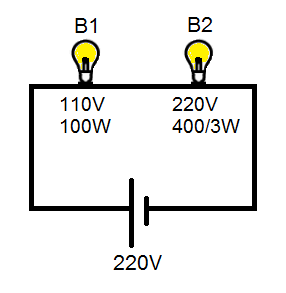
Total power consumption for the given circuit is:

(A) $25\;W$
(B) $50\;W$
(C) $100\;W$
(D) $75\;W$
Answer
218.1k+ views
Hint To find the power consumption for the given circuit, first we calculate the individual resistances of each bulb then as the bulbs are connected in series, we can find the equivalent resistance of the complete circuit. Using equivalent resistance and the voltage of the complete circuit, power can be easily calculated.
Formula used:
$P = \dfrac{{{V^2}}}{R}$
Where P stands for the power, V stands for the voltage and R stands for the resistance.
Complete step by step answer
Let us first consider the ${B_1}$.
The voltage of the bulb ${B_1}$ is given as, ${V_1} = 110V$
Power of the bulb ${B_1}$ is given as, ${P_1} = 100W$
The resistance of the bulb ${B_1}$ can be calculated as, ${R_1} = \dfrac{{{V_1}^2}}{{{P_1}}}$
$ \Rightarrow {R_1} = \dfrac{{{{110}^2}}}{{100}}$
$ \Rightarrow {R_1} = \dfrac{{110 \times 110}}{{100}}$
$ \Rightarrow {R_1} = 121\Omega $
Now, let us consider the second bulb, ${B_2}$.
The voltage of the bulb ${B_2}$ is given as, ${V_2} = 220V$
Power of the bulb ${B_2}$ is given as, ${P_2} = \dfrac{{400}}{3}W$
The resistance of the bulb ${B_2}$ can be calculated as, ${R_2} = \dfrac{{{V_2}^2}}{{{P_2}}}$
$ \Rightarrow {R_2} = \dfrac{{{{220}^2}}}{{\dfrac{{400}}{3}}}$
$ \Rightarrow {R_2} = \dfrac{{220 \times 220 \times 3}}{{400}}$
$ \Rightarrow {R_2} = 363\Omega $
As we can see in the circuit, the bulbs ${B_1}$ and ${B_2}$ are connected in series.
So, the equivalent resistance of the circuit can be given as, ${R_{eq}} = {R_1} + {R_2}$
${R_{eq}} = (121 + 363)\Omega $
${R_{eq}} = 484\Omega $
The voltage of the complete circuit, $V = 220V$
Total power consumption for the given circuit, $P = \dfrac{{{V^2}}}{{{R_{eq}}}}$
$ \Rightarrow P = \dfrac{{{{220}^2}}}{{484}}$
$ \Rightarrow P = \dfrac{{220 \times 220}}{{484}}$
$ \Rightarrow P = 100W$
So, the total power consumption for the given circuit is $100\;W$.
Hence, The correct answer is option (C) $100\;W$.
Note There are two formulae to calculate the power of a given circuit:
1. $P = {I^2}R$, where I stands for the current and R stands for the resistance
2. $P = \dfrac{{{V^2}}}{R}$ , where V stands for the voltage and R stands for the resistance
We use these formulae depending on the quantities provided to us in the question. Here, the voltages of individual bulbs and also the voltage of the complete circuit are given to us, so we have used the second formula.
Formula used:
$P = \dfrac{{{V^2}}}{R}$
Where P stands for the power, V stands for the voltage and R stands for the resistance.
Complete step by step answer
Let us first consider the ${B_1}$.
The voltage of the bulb ${B_1}$ is given as, ${V_1} = 110V$
Power of the bulb ${B_1}$ is given as, ${P_1} = 100W$
The resistance of the bulb ${B_1}$ can be calculated as, ${R_1} = \dfrac{{{V_1}^2}}{{{P_1}}}$
$ \Rightarrow {R_1} = \dfrac{{{{110}^2}}}{{100}}$
$ \Rightarrow {R_1} = \dfrac{{110 \times 110}}{{100}}$
$ \Rightarrow {R_1} = 121\Omega $
Now, let us consider the second bulb, ${B_2}$.
The voltage of the bulb ${B_2}$ is given as, ${V_2} = 220V$
Power of the bulb ${B_2}$ is given as, ${P_2} = \dfrac{{400}}{3}W$
The resistance of the bulb ${B_2}$ can be calculated as, ${R_2} = \dfrac{{{V_2}^2}}{{{P_2}}}$
$ \Rightarrow {R_2} = \dfrac{{{{220}^2}}}{{\dfrac{{400}}{3}}}$
$ \Rightarrow {R_2} = \dfrac{{220 \times 220 \times 3}}{{400}}$
$ \Rightarrow {R_2} = 363\Omega $
As we can see in the circuit, the bulbs ${B_1}$ and ${B_2}$ are connected in series.
So, the equivalent resistance of the circuit can be given as, ${R_{eq}} = {R_1} + {R_2}$
${R_{eq}} = (121 + 363)\Omega $
${R_{eq}} = 484\Omega $
The voltage of the complete circuit, $V = 220V$
Total power consumption for the given circuit, $P = \dfrac{{{V^2}}}{{{R_{eq}}}}$
$ \Rightarrow P = \dfrac{{{{220}^2}}}{{484}}$
$ \Rightarrow P = \dfrac{{220 \times 220}}{{484}}$
$ \Rightarrow P = 100W$
So, the total power consumption for the given circuit is $100\;W$.
Hence, The correct answer is option (C) $100\;W$.
Note There are two formulae to calculate the power of a given circuit:
1. $P = {I^2}R$, where I stands for the current and R stands for the resistance
2. $P = \dfrac{{{V^2}}}{R}$ , where V stands for the voltage and R stands for the resistance
We use these formulae depending on the quantities provided to us in the question. Here, the voltages of individual bulbs and also the voltage of the complete circuit are given to us, so we have used the second formula.
Recently Updated Pages
Arithmetic, Geometric & Harmonic Progressions Explained

Cartesian Form of Vector Explained: Formula, Examples & Uses

Apparent Frequency Explained: Formula, Uses & Examples

Calorimetry: Definition, Principles & Calculations

Centrifugal Force Explained: Definition, Formula & Examples

Charge in a Magnetic Field: Definition, Formula & Examples

Trending doubts
Understanding Collisions: Types and Examples for Students

Ideal and Non-Ideal Solutions Explained for Class 12 Chemistry

Degree of Dissociation: Meaning, Formula, Calculation & Uses

Understanding the Wheatstone Bridge: Principles, Formula, and Applications

Formula for number of images formed by two plane mirrors class 12 physics JEE_Main

JEE Main 2025-26 Mock Test: Ultimate Practice Guide for Aspirants

Other Pages
MOSFET: Definition, Working Principle, Types & Applications

Diffraction of Light - Young’s Single Slit Experiment

Electric field due to uniformly charged sphere class 12 physics JEE_Main

Dual Nature of Radiation and Matter Class 12 Physics Chapter 11 CBSE Notes - 2025-26

JEE Main 2025-26 Chapter-Wise Mock Test Preparation Guide

Understanding Elastic Collisions in Two Dimensions




